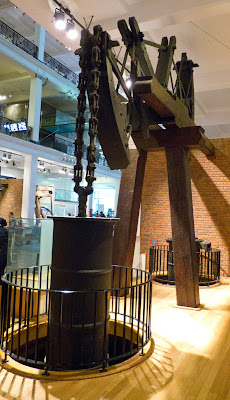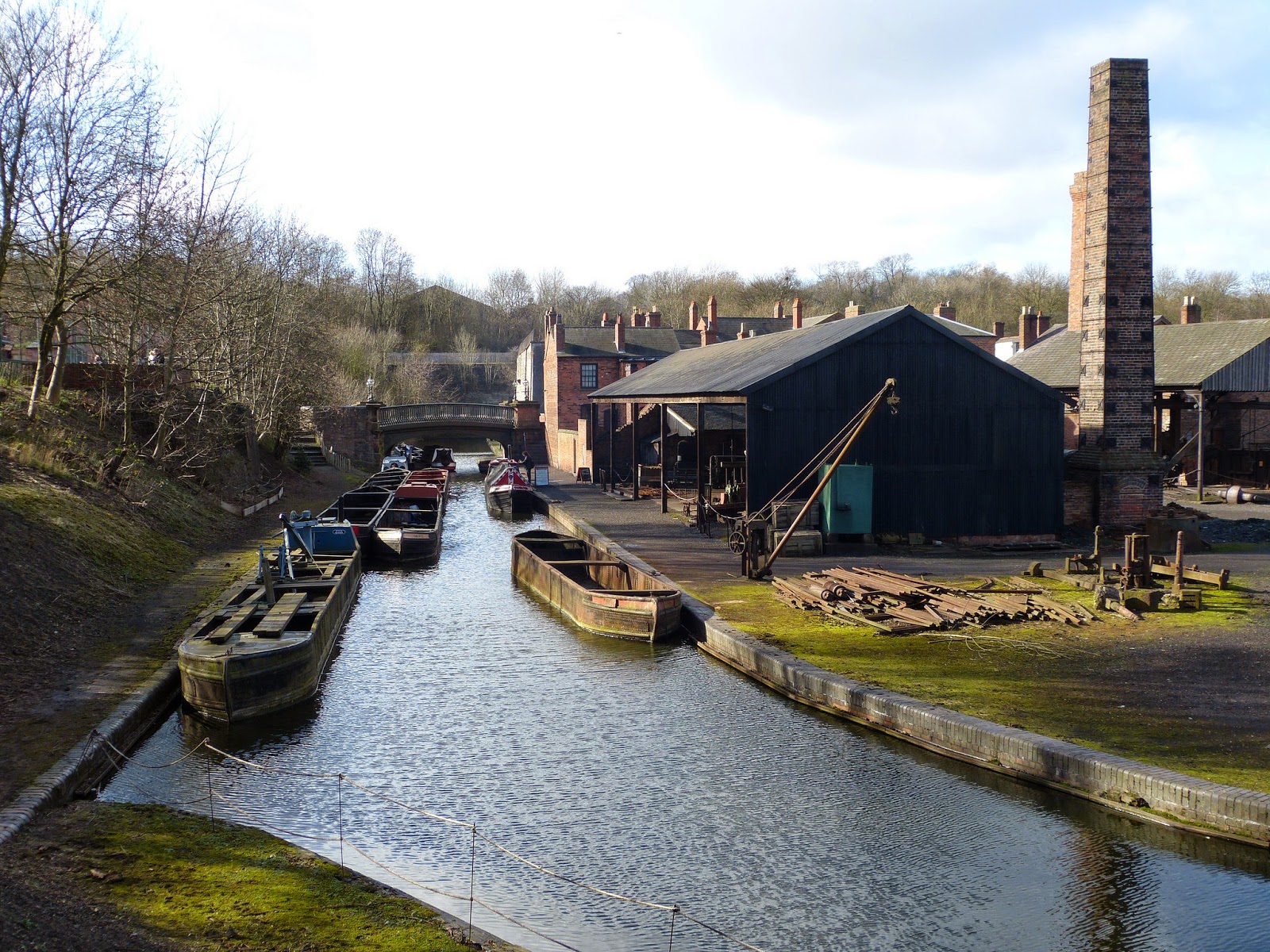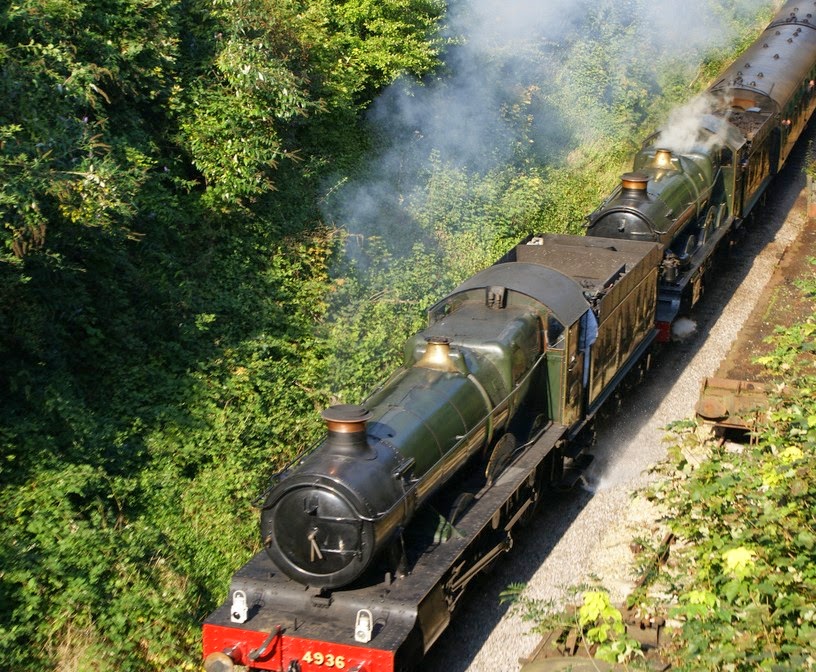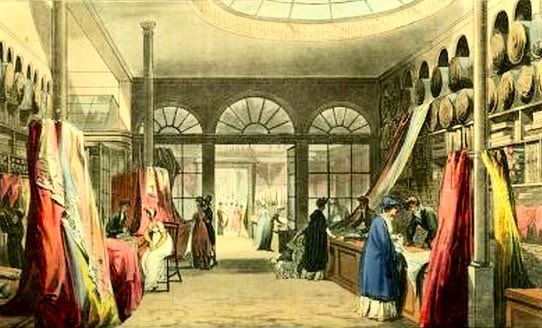In 1712, two years before a portly German prince arrived from Hanover to become George I, Thomas Newcomen (1664-1729) installed an innovative water pump at a mine in Staffordshire. Newcomen’s device, the first commercially successful steam engine, solved a practical problem of extracting floodwater from mines. It also began the era of technological development we refer to as the Industrial Revolution.
 |
| A working replica of Newcomen's steam engine at the Black Country Living Museum, Dudley (2014) |
Such was the success of Newcomen’s steam engine that hundreds were built over the next hundred years and it would be half a century before the design was significantly improved on. In the 1770s, Scottish engineer James Watt (1736-1819) dramatically improved the engine’s efficiency. He went into partnership with Matthew Boulton (1728-1809) to manufacture the machines, making him immensely wealthy.
 |
| 'Old Bess' engine by Boulton and Watt (1777) in the Science Museum, London (2014) |
By 1800 steam engines powered a host of industries including mining and manufacturing.
The next major innovation was using steam to power a vehicle. Early models were developed in the 1780s and 90s but the first full-size engine was constructed by Richard Trevithick (1771-1833).
The coming of the railways
On 21 February 1804, Trevithick's engine made the world’s first steam-driven railway journey, pulling a train in South Wales.
The first railway opened to the public was the Liverpool and Manchester Railway, opened in 1830. The previous year they organised the Rainhill Trials, won by Robert Stephenson’s Rocket, securing him the contract to build engines for the new railway.
By 1837, when Queen Victoria came to the throne, steam railways were being built across the world, and steam engines were being put to many different uses.
The next major innovation was using steam to power a vehicle. Early models were developed in the 1780s and 90s but the first full-size engine was constructed by Richard Trevithick (1771-1833).
The coming of the railways
On 21 February 1804, Trevithick's engine made the world’s first steam-driven railway journey, pulling a train in South Wales.
The first railway opened to the public was the Liverpool and Manchester Railway, opened in 1830. The previous year they organised the Rainhill Trials, won by Robert Stephenson’s Rocket, securing him the contract to build engines for the new railway.
By 1837, when Queen Victoria came to the throne, steam railways were being built across the world, and steam engines were being put to many different uses.
Ironbridge Gorge, Shropshire, has been awarded World Heritage Site status because of its key role in the Industrial Revolution.
Here, in 1709, Abraham Darby (1678-1717) was the first person to smelt iron in a furnace powered by coke, rather than charcoal. Using coke, made from coal which was locally abundant, removed the reliance on wood, an increasingly scarce resource. It also meant much more iron could be produced. Coalbrookedale, where Darby was working, became a centre of innovation and industry for decades.
In 1779, the world’s first iron bridge was completed, crossing the gorge. The iron bridge is now a monument to the Industrial Revolution.
Mechanisation of the textile industry
During the seventeenth century, cotton fabric became increasingly popular. Lighter and easier to wash than wool, cotton garments were initially imported from India while domestic spinning and weaving industries developed slowly, the work carried out by hand, typically in homes.
James Hargreaves (1720-1778) and Richard Arkwright (1732-1792) both introduced mechanisation to the cotton industry in the 1760s. Hargreaves invented the Spinning Jenny while Arkwright created the Water Frame.
Arkwright built ‘manufactories’ to house his machines and employed hundreds of unskilled workers to operate them. He also took advantage of steam power, using a Watts engine to pump the water that drove his machines.
By the 1790s, Britain was producing over a million cotton garments a year. Reaction against increased mechanisation included the Luddite riots of 1811-1813, where many machines were destroyed by workers who felt threatened by new technology.
Here, in 1709, Abraham Darby (1678-1717) was the first person to smelt iron in a furnace powered by coke, rather than charcoal. Using coke, made from coal which was locally abundant, removed the reliance on wood, an increasingly scarce resource. It also meant much more iron could be produced. Coalbrookedale, where Darby was working, became a centre of innovation and industry for decades.
In 1779, the world’s first iron bridge was completed, crossing the gorge. The iron bridge is now a monument to the Industrial Revolution.
Mechanisation of the textile industry
During the seventeenth century, cotton fabric became increasingly popular. Lighter and easier to wash than wool, cotton garments were initially imported from India while domestic spinning and weaving industries developed slowly, the work carried out by hand, typically in homes.
James Hargreaves (1720-1778) and Richard Arkwright (1732-1792) both introduced mechanisation to the cotton industry in the 1760s. Hargreaves invented the Spinning Jenny while Arkwright created the Water Frame.
Arkwright built ‘manufactories’ to house his machines and employed hundreds of unskilled workers to operate them. He also took advantage of steam power, using a Watts engine to pump the water that drove his machines.
By the 1790s, Britain was producing over a million cotton garments a year. Reaction against increased mechanisation included the Luddite riots of 1811-1813, where many machines were destroyed by workers who felt threatened by new technology.
The population of Britain in 1750, at 5.7 million people, was probably not dissimilar to the number living here in Roman times. It was also the maximum number that could be fed by the land using contemporary agricultural methods.
By 1850 the population had more than doubled to 16.6 million. New ideas about farming, combined with new technologies, meant more food could be produced from the same area of land. During the same period large areas of land were made usable through drainage or deforestation.
Canals and roads
By 1850 the population had more than doubled to 16.6 million. New ideas about farming, combined with new technologies, meant more food could be produced from the same area of land. During the same period large areas of land were made usable through drainage or deforestation.
Canals and roads
As the population grew, along with demand for new products, the nation’s transport infrastructure required improvement. The final quarter of the eighteenth century was the great age of canal building, starting with the Bridgewater Canal which opened in 1776. By 1810 Britain was criss-crossed by over four thousand miles of artificial waterways, traversed by thousands of barges carrying coal, clay and manufactured goods.
 |
| Canal at the Black Country Living Museum, Dudley (2014) |
While canals provided transport for large quantities of heavy or bulky items, the majority of people who travelled any distance did so by road. Poor maintenance and increasing volumes of traffic damaged the surface of many roads, which were unpaved and could become almost impassable in bad weather.
The solution was the Turnpike system, which began in the late seventeenth century and lasted until the 1870s. Turnpikes were toll roads, managed by Turnpike Trusts, where money was invested in building a more solid surface, making it easier for horses and carriages to travel at a reasonable speed. In 1825 there were one thousand Turnpike Trusts controlling 18,000 miles of road.
The solution was the Turnpike system, which began in the late seventeenth century and lasted until the 1870s. Turnpikes were toll roads, managed by Turnpike Trusts, where money was invested in building a more solid surface, making it easier for horses and carriages to travel at a reasonable speed. In 1825 there were one thousand Turnpike Trusts controlling 18,000 miles of road.
 |
| Table of tolls at the Weald and Downland Open Air Museum (2014) |
In the early nineteenth century, the rate of building of new canals and Turnpike roads slowed dramatically, as railways became an increasingly popular alternative.
Peace allowed freedom of thought
The Industrial Revolution was the result of many factors that combined during the eighteenth century. One of these was the relative peace enjoyed by the country, particularly later in the century, when many other European nations were being ravaged by war.
This relative peace, and along with it the reign of the Hanoverian kings, was secured in 1746 at the last pitched battle in Britain, at Culloden. The destruction and disruption which follows the movement of armies during wartime ceased.
At the same time, neither the monarchy nor the church sought to impose strict controls on society, allowing free thought and experimentation to flourish. Public lectures on science, or ‘natural philosophy’ as it was known at the time, became popular during the first half of the eighteenth century.
George III, who became king in 1760, was fascinated by science. He collected, or had made, numerous scientific instruments that were used to both entertain and instruct. His collection, which includes air pumps, globes of the known world and a model diving bell, is now on display in the Science Museum, London.
Peace allowed freedom of thought
The Industrial Revolution was the result of many factors that combined during the eighteenth century. One of these was the relative peace enjoyed by the country, particularly later in the century, when many other European nations were being ravaged by war.
This relative peace, and along with it the reign of the Hanoverian kings, was secured in 1746 at the last pitched battle in Britain, at Culloden. The destruction and disruption which follows the movement of armies during wartime ceased.
At the same time, neither the monarchy nor the church sought to impose strict controls on society, allowing free thought and experimentation to flourish. Public lectures on science, or ‘natural philosophy’ as it was known at the time, became popular during the first half of the eighteenth century.
George III, who became king in 1760, was fascinated by science. He collected, or had made, numerous scientific instruments that were used to both entertain and instruct. His collection, which includes air pumps, globes of the known world and a model diving bell, is now on display in the Science Museum, London.
 |
| Air pump made for George III by George Adams (1761) (Photo 2014) |
Rachel Knowles writes faith-based Regency romance and historical non-fiction. She has been sharing her research on this blog since 2011. Rachel lives in the beautiful Georgian seaside town of Weymouth, Dorset, on the south coast of England, with her husband, Andrew, who wrote this blog.
Find out more about Rachel's books and sign up for her newsletter here.If you have enjoyed this blog and want to encourage us and help us to keep making our research freely available, please buy us a virtual cup of coffee by clicking the button below.
Sources used include:
BBC history website: Agricultural revolution, James Watt, Sir Richard Arkwright, the inventors of the steam engine and why the industrial revolution happened in Britain
Canal museum
English Heritage website: Ironbridge
Ironbridge website
Saburchill.com: History of the cotton industry
Science museum: King George III's collection and Rise of the factory system
Smithsoniam: What the Luddites really fought against
Turnpike roads in England
Wikipedia: Industrial Revolution, steam locomotive and timeline of steam power
Photographs © Andrew Knowles RegencyHistory.net
English Heritage website: Ironbridge
Ironbridge website
Saburchill.com: History of the cotton industry
Science museum: King George III's collection and Rise of the factory system
Smithsoniam: What the Luddites really fought against
Turnpike roads in England
Wikipedia: Industrial Revolution, steam locomotive and timeline of steam power
Photographs © Andrew Knowles RegencyHistory.net




Fascinating look at the roots of industrialization in the Regency Period. We tend to think of JA's world as pre-industrial, but Blake wrote about the "Dark Satanic Mills" already in 1804.
ReplyDeleteAbsolutely! Jane Austen lived through a time of tremendous change both in industry and transport.
Delete